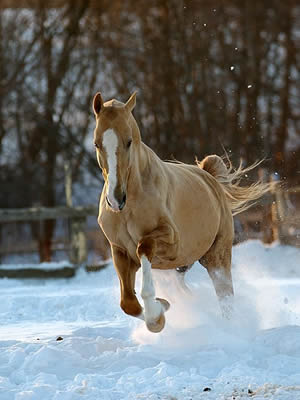General Description
Palomino is a horse color not a breed. The characteristic palomino color is that of a newly minted fourteen-karat gold coin with variations from light to dark. The skin is usually gray, black, brown or motley without underlying pink skin or spots, except on the face or legs. The eyes are usually black, hazel, or brown. The mane and tail must be white with not more than fifteen percent dark, sorrel, or chestnut hairs. Conformation depends on the breed represented but most stand between 14 and 17 hands.
Technically, the palomino is not so much a color as it is a lack of color due to the dilution gene. The best cross for obtaining a palomino has been the crossing of a palomino to a chestnut. Crossing a palomino to a palomino most often produces a cremello (often called wrongly, an albino).
Many non-palominos may also have a gold or tan coat and a light mane and tail.
* Chestnut with flaxen mane and tail: Lighter chestnuts with a light cream mane and tail carry a flaxen gene, but not a cream dilution. For example, the Haflinger breed has many light chestnuts with flaxen that may superficially resemble dark palomino, but there is no cream gene in the breed.
* Cremellos carry two copies of the cream gene and have a light mane and tail but also a cream-colored hair coat, rosy pink skin and blue eyes.
* The champagne gene is the most similar palomino mimic, as it creates a golden-colored coat on some horses, but golden champagnes have light skin with mottling, blue eyes at birth, and amber or hazel eyes in adulthood.
Horses with a very dark brown coat but a flaxen mane and tail are sometimes called "chocolate palomino," and some palomino color registries accept horses of such color. However, this coloring is not genetically palomino. There are two primary ways the color is created. The best-known is a liver chestnut with a flaxen mane and tail. The genetics that create light flaxen manes and tails on otherwise chestnut horses are not yet fully understood, but they are not the same as the cream dilution. The other genetic mechanism is derived from the silver dapple gene, which lightens a black coat to dark brown, and affects the mane and tail even more strongly, diluting to cream or near-white.
* Buckskins have a golden body coat but a black mane and tail. Buckskin is also created by the action of a single cream gene, but on a bay coat.
* Dun horses have a tan body with a darker mane and tail plus primitive markings such as a dorsal stripe down the spine and horizontal striping on the upper back of the forearm.
* The pearl gene in a homozygous state creates a somewhat apricot-colored coat with pale skin. When crossed with a single cream gene, the resulting horse, often called a "pseudo-double-dilute", appears visually to be a cremello.






